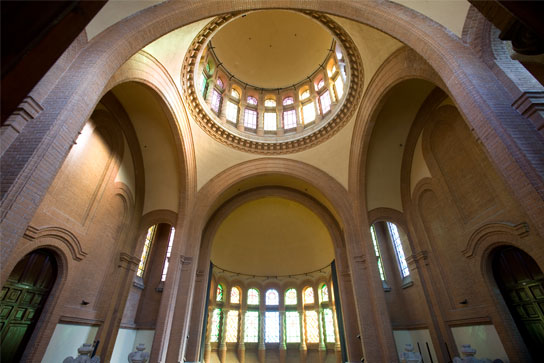


First solution
Ayre Hotel Rosellón, a four-star hotel in Barcelona with an urban and cosmopolitan design, is located in a privileged location in the vital commercial and tourist hub of the city, in the heart of the Eixample quarter. Barely 200 metres from the majestic Basilica of the Sagrada Familia, the hotel’s panoramic terrace and a number of its rooms provide guests with unique and exclusive views of Antoni Gaudi's as yet unfinished temple.
Ayre Hotel Rosellón is very close to other points of interest, such as Barcelona’s Zoo, the Mercado de los Encantes Viejos, Barcelona’s Monumental Bull Ring, the National Theatre of Catalunya, Casa Batlló, La Pedrera and other works along the Paseo de Gràcia.
Located in the beautiful cosmopolitan city of Barcelona, Ayre Hotel Rosellón invites you to revel in its history, culture, and art, offering spectacular views of Antoni Gaudí's architectural treasure, the Expiatory Church of the Sagrada Familia. Note that Ayre Hotel Rosellón is one of a kind. No other hotel in Barcelona has such direct and exclusive views of Gaudí's unfinished modernistic work, which is the city's main tourist attraction, and the most visited monument in Spain.
Second solution
The Amrey Sant Pau Hotel**, located in the city of Barcelona and overlooking the architectural ensemble of the Sant Pau Hospital.
The Hotel offers facilities and services of high quality at a very competitive price.
The Amrey Sant Pau Hotel is a landmark hotel in Barcelona. It offers quality facilities and comfortable accommodations with views of the iconic modernist building of Sant Pau Hospital. Some rooms also have a terrace where you can enjoy beautiful views of the city of Barcelona.
The hotel offers free Wi-Fi to customers in all its facilities, function rooms for meetings and parking in the same building.
Do not miss visiting our restaurant and try our delicious menus with Mediterranean recipes, as well as a cafe where you can relax in a warm and friendly atmosphere. We also offer a buffet breakfast to start the day with energy.


For more information see Casa de Convalescència
The I3M 2017 Organization Committee would like to invite the conference attendees to join the I3M Welcome Ceremony that will be held at Palau Robert on September 18, 2017 from 8:00 pm to 9:00 pm.
Barcelona’s Palau Robert is an exhibition center run by the Government of Catalonia. With more than one thousand square metres devoted to its activities, the centre is housed in a neoclassical building at the junction of Avinguda Diagonal and Passeig de Gràcia, two of the most important thoroughfares in the Catalan capital. We look forward to welcome you in Barcelona for the I3M 2017 Multiconference!
Barcelona, the capital of Catalonia, is a Mediterranean and cosmopolitan city with Roman remains, medieval quarters and the most beautiful examples of 20th century Modernism and avant-garde. It is no surprise that emblematic constructions by the Catalan architects Antoni Gaudí and Lluís Doménech i Montaner have been declared World Heritage Sites by UNESCO.
The city's origins are Roman, and its long history and economic dynamism have made Barcelona a cultural city, which can be seen in the historic-artistic heritage and the promotion of the most innovative artistic trends. A wide cultural programme will take visitors to museums, exhibitions, open-air sculptures… and many concerts, plays and dances. Popular culture also has its manifestations in this city, which still conserves its most cherished traditions, like the fiestas of La Mercè or the festivities in the neighbourhoods of Gràcia, Sants and Poblenou. These are all exceptional opportunities for getting to know the city's more festive side.
Tradition and modernity can also be seen in its innovative and imaginative gastronomy, based on fresh garden produce, fresh fish, a wide variety of sausages and olive oil. Traditional handmade cakes and pastries and sparkling wines are some of the other highlights in this brief overview of Barcelona's gastronomic culture.
Strolling around the streets of Barcelona will bring surprises at every turn. Pedestrian streets in the old quarter, green spaces, and a splendid seafront with a range of modern facilities are a reflection of its multi-faceted character. Barcelona has cleverly succeeded in embracing its past without forgetting its commitment to the future. The city is endowed with some exceptional infrastructures which are in demand as venues for seminars, symposia and international events. Its exceptional transport connections, the Mediterranean climate and the multitude of attractions for visitors make Barcelona one of the world's leading business cities. Business parks and exhibition and conference centres host a wide range of initiatives.
Visitors coming to Barcelona for pleasure or on business can also enjoy the city's Mediterranean character, which can so clearly be seen on the Barc elona coast. The city also has lovely urban beaches, marine resorts, and golf courses on the seashore. Nature lovers will not have to go far to explore the mountains in the Cordillera Litoral range and the Catalan Pyrenees.